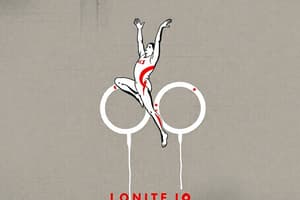Podcast
Questions and Answers
Who is considered the 'Father of Gymnastics'?
Who is considered the 'Father of Gymnastics'?
- Perh Ling
- Friedrich Jahn (correct)
- Adolf Spiess
- Dr. Dudley Sergeant
Adolf Spiess is known for introducing gymnastics as part of the school curriculum in the United States.
Adolf Spiess is known for introducing gymnastics as part of the school curriculum in the United States.
False (B)
What did Perh Ling invent that is used in gymnastics?
What did Perh Ling invent that is used in gymnastics?
stall bars and vaulting box
Gymnastics emphasizes the importance of __________, poise, and dignity of movements.
Gymnastics emphasizes the importance of __________, poise, and dignity of movements.
Match the following gymnastic figures with their contributions:
Match the following gymnastic figures with their contributions:
Which of the following is NOT considered a key element in a gymnastics program?
Which of the following is NOT considered a key element in a gymnastics program?
Tumbling is considered the least important phase of the gymnastics program.
Tumbling is considered the least important phase of the gymnastics program.
What type of gymnastics combines routines with music?
What type of gymnastics combines routines with music?
The phase of gymnastics where performers test their physical abilities through various playful activities is called _______.
The phase of gymnastics where performers test their physical abilities through various playful activities is called _______.
Match the following gymnastics phases with their descriptions:
Match the following gymnastics phases with their descriptions:
Study Notes
History of Gymnastics
-
Gymnastics originated in ancient times with activities like swinging, climbing ropes, and balancing on logs.
-
The Chinese practiced "Kung Fu" or "Medical Gymnastics", while India had "Yoga".
-
The Greeks developed the word "gymnastics", which meant "Naked Art" and incorporated apparatuses in their exercises.
-
The Romans, known for their love of war, created equipment similar to a horse's back for indoor training in mounting and dismounting.
-
The Germans were significant contributors to modern gymnastics.
People Behind the Development of Gymnastics
-
Johann Basedow (1723-1790), introduced gymnastics into the school curriculum.
-
Johann Guts Muths (1759-1839), called the “Great Grandfather of Gymnastics”, wrote a book titled "Gymnastics for the Youth".
-
Friedrich Jahn (1778-1852), known as the “Father of Gymnastics”, started the Turnverein movement and introduced apparatuses like the horizontal bar, parallel bars, side horse, and vaulting buck.
-
Adolf Spiess (1810-1858) introduced marching and freehand exercises performed with music.
-
Perh Ling (1776-1839), a Swedish enthusiast, invented stall bars and the vaulting box, also known as the Swedish box.
-
Dr. Dudley Sergeant, an American, significantly influenced gymnastics in America by incorporating it into the school curriculum.
-
Filipino folk dancer and academic, Mrs. Francisca Aquino from the Bureau of Public Schools helped establish gymnastics in the Philippines alongside exponents from the University of the Philippines.
What is Gymnastics?
-
Gymnastics is a self- motivating activity involving varying body positions and movements.
-
Proper body preparation, particularly strength and flexibility, is essential for acquiring gymnastics skills.
-
Modern gymnastics places emphasis on flowing movements incorporating dance and locomotor skills.
-
Grace, poise, and dignity of movement are emphasized.
-
The masculine and rigid movements of the past have evolved to include more relaxed and easy movements.
Phases of the Gymnastics Program
Conditioning Program
-
The conditioning program prepares the body for complex movements and skills.
-
It includes warm-up exercises.
-
Routines can be created from the exercises, making it similar to "Calisthenics".
Rhythmic Gymnastics
-
Rhythmic Gymnastics incorporates exercises and routines performed with music.
-
These exercises are performed rhythmically with flowing movements.
-
It includes freehand exercises and exercises using light apparatuses like wands, rings, hoops, ribbons, and ropes.
Stunts
-
Gymnastics stunts are playful activities testing strength, flexibility, balance, agility, endurance, and coordination.
-
These stunts are particularly suitable for lower grades.
-
Some stunts can be considered conditioning exercises, while others are preparatory for tumbling stunts.
Tumbling
- The most important phase of gymnastics, where the performer’s ability is tested through rolls, twists, turns, and springs on the mat, floor, and in the air.
Apparatus Exercise (Heavy)
- This phase involves exercises on the balance beam, vaulting horse, parallel bars, uneven bars, rings, and trampoline.
Pyramid Building
-
Participants create a static body position mural, forming the shape of a pyramid.
-
Positions must be correctly arranged and selected for this static formation.
Gymnastics Objectives
-
Improve and maintain a physically fit body.
-
Enhance efficiency of movement through grace, poise, dignity, form, and rhythm.
-
Foster creativity through exploration of new movements and movement combinations.
-
Develop courage, initiative, determination, and perseverance.
-
Stimulate interest and enjoyment in gymnastics.
Studying That Suits You
Use AI to generate personalized quizzes and flashcards to suit your learning preferences.
Related Documents
Description
Explore the rich history of gymnastics from its ancient origins to modern developments. Learn about key figures such as Johann Basedow, Johann Guts Muths, and Friedrich Jahn, who significantly shaped the discipline. Discover how gymnastics evolved with different cultures and their contributions to the practice we see today.




